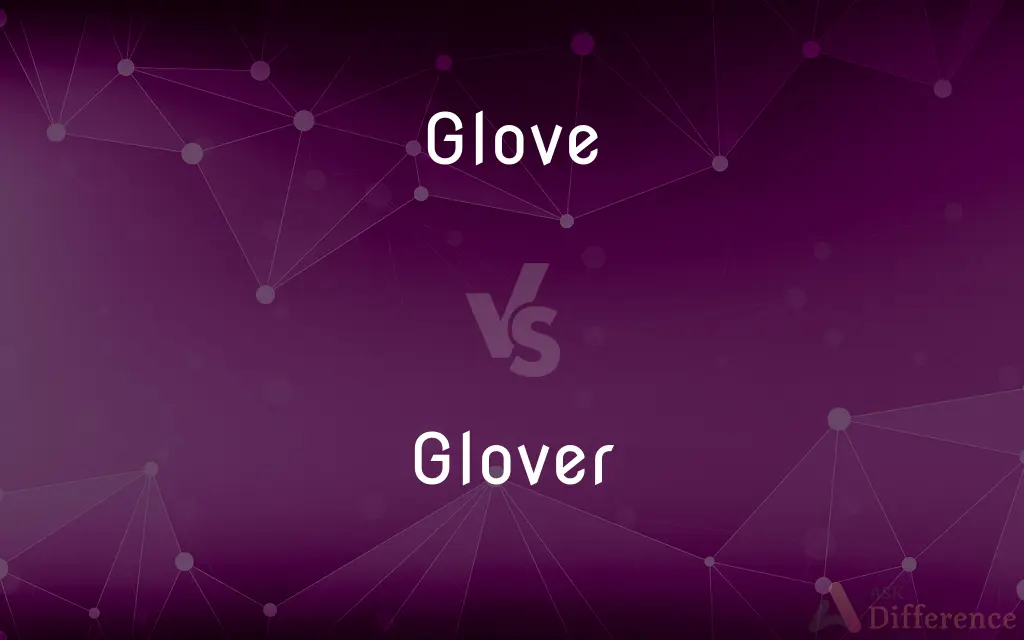Glove vs. Glover — What's the Difference?
By Maham Liaqat & Fiza Rafique — Updated on May 4, 2024
A glove is a hand covering for protection or warmth, while a glover is a person who makes or sells gloves.

Difference Between Glove and Glover
Table of Contents
ADVERTISEMENT
Key Differences
A glove is typically made from materials like leather, cloth, or rubber, designed to fit over the hand with separate sections for each finger. On the other hand, a glover is a craftsman or merchant involved in the glove-making industry, focusing on the creation or distribution of gloves.
Gloves serve various purposes, including protection from cold, injury, or contamination in different settings like medical facilities, workshops, or sports. Whereas, glovers are skilled artisans or business persons whose expertise and livelihood depend on the demand for various types of gloves.
The design and complexity of gloves can vary from simple knitted winter gloves to sophisticated high-tech gloves used in sports and industry. Meanwhile, glovers may specialize in specific types of gloves, adapting their skills to changes in materials and consumer preferences.
Gloves are essential items in many professions and activities, providing safety and comfort. In contrast, glovers face market fluctuations and must adapt to the evolving needs and technologies in glove production to maintain their relevance and business.
While gloves are often subject to fashion trends and functional requirements, influencing their design and material choice, glovers must stay informed about these trends to craft products that meet current demands and standards.
ADVERTISEMENT
Comparison Chart
Definition
A covering for the hand with separate parts for fingers
A person who makes or sells gloves
Purpose
Protection, warmth, or special functionality
Manufacture and commerce of gloves
Material Varieties
Leather, cloth, rubber, and more
Deals with various materials as per glove demand
Associated Professions
Healthcare, sports, fashion, and more
Craftsmanship, retail, and wholesale
Trends and Changes
Subject to changes in fashion and technology
Must adapt to market and material changes
Compare with Definitions
Glove
Critical in many professions for hygienic purposes.
Doctors wear sterile gloves during surgeries.
Glover
A craftsman specialized in the creation of gloves.
The glover displayed his finest leather work at the fair.
Glove
A hand garment covering each finger separately for protection or warmth.
She wore thick gloves to handle the snow.
Glover
Faces economic challenges based on the fluctuating demand for gloves.
The glover expanded his sales online to reach a broader market.
Glove
Can be a fashion statement in various materials like lace or silk.
She completed her outfit with elegant silk gloves.
Glover
A retailer specializing in selling various types of gloves.
The glover's shop in the market was well-known for its variety.
Glove
Specialized gloves include tech features for specific uses.
He used heated gloves for mountain climbing.
Glover
Adapts to market needs and trends in glove manufacturing.
The glover introduced eco-friendly materials in his new line.
Glove
Often used in sports to enhance grip or safety.
Baseball players wear gloves for catching balls safely.
Glover
Involved in both the design and production of gloves.
As a glover, he innovated with new materials to improve durability.
Glove
A glove is a garment covering the hand. Gloves usually have separate sheaths or openings for each finger and the thumb.
Glover
A person who makes or sells gloves.
Glove
A close-fitting covering for the hand with a separate sheath for each finger and the thumb, worn especially as protection from the cold.
Glover
One whose trade it is to make or sell gloves.
Glove
A gauntlet.
Glove
An oversized leather glove used for catching baseballs, especially one with more finger sheaths than the catcher's or first baseman's mitt.
Glove
A glove made of leather and fabric having padding on the back and extending over the wrist, used in hockey and lacrosse.
Glove
A boxing glove.
Glove
A close-fitting glove used to improve the grip, as in batting or in golf.
Glove
(Baseball) Fielding ability
A shortstop with a good glove.
Glove
To furnish with gloves.
Glove
To cover with or as if with a glove.
Glove
To don gloves, as before performing an operation on a patient.
Glove
An item of clothing, covering all or part of the hand and fingers, but usually allowing independent movement of the fingers.
I wore gloves to keep my hands warm.
The boxing champ laced on his gloves before the big bout.
Glove
A baseball mitt.
Glove
The ability to catch a hit ball.
Frederico had a great glove, but he couldn't hit a curveball, so he never broke into the pros.
Glove
(slang) A condom.
Glove
(with definite article) A challenge from one to another.
To throw down the glove, i.e. to offer a challenge; to take up the glove, to accept it
Glove
To catch the ball in a baseball mitt.
He gloved the line drive for the third out.
Glove
(transitive) To put a glove or gloves on.
Maxwell gloved his hand so that he wouldn't leave fingerprints, then pulled the trigger.
Glove
(cricket) To touch a delivery with one's glove while the gloved hand is on the bat. Under the rules of cricket, the batsman is deemed to have hit the ball.
Glove
A cover for the hand, or for the hand and wrist, with a separate sheath for each finger. The latter characteristic distinguishes the glove from the mitten.
Glove
A boxing glove.
Glove
To cover with, or as with, a glove.
Glove
Gloves worn by fielders in baseball
Glove
Handwear: covers the hand and wrist
Glove
Gloves that are big and padded; worn for boxing
Common Curiosities
Are there eco-friendly gloves?
Yes, eco-friendly gloves made from biodegradable or recycled materials are available, appealing to environmentally conscious consumers.
What is the historical significance of gloves in fashion?
Historically, gloves have symbolized status and etiquette, particularly in formal and royal attire.
Can gloves be recycled?
Some gloves, especially those made from natural materials, can be recycled or repurposed, but many synthetic gloves are not recyclable.
How do glovers source their materials?
Glovers source materials from suppliers who specialize in textiles, leathers, and synthetics, often choosing based on quality, cost, and sustainability.
What role do gloves play in safety at workplaces?
Gloves protect workers from chemicals, cuts, burns, and cold, essential for maintaining safety in various industries.
What training does a glover need?
Glovers often learn through apprenticeships or specialized training programs focusing on textile manipulation and design.
Do gloves have a seasonality in sales?
Yes, glove sales are typically higher in colder months and in sectors with specific safety or performance requirements.
What are the most challenging aspects of being a glover?
Challenges include maintaining craftsmanship standards, adapting to market trends, and managing material costs.
What innovations are there in the glove industry?
Innovations include smart gloves with embedded technology for touch screens, enhanced grip, or health monitoring.
What legal regulations affect glove manufacturing?
Regulations may relate to safety standards, material sourcing, and labor practices in the manufacturing process.
How has the demand for gloves changed over the years?
Demand has fluctuated with changes in fashion trends, health concerns, and industry safety standards.
What is the average lifespan of a high-quality glove?
High-quality gloves can last several years with proper care, depending on the material and usage.
How do cultural differences affect glove designs?
Cultural preferences influence glove designs, especially in terms of materials, colors, and decorative elements.
How do glovers compete in the market?
Glovers compete through product quality, innovation, niche marketing, and customer service.
Can gloves be custom-made?
Yes, many glovers offer custom-made gloves, tailored to the specific needs or preferences of the customer, often at a higher price point.
Share Your Discovery

Previous Comparison
Copier vs. Printer
Next Comparison
Choice vs. DecisionAuthor Spotlight
Written by
Maham LiaqatCo-written by
Fiza RafiqueFiza Rafique is a skilled content writer at AskDifference.com, where she meticulously refines and enhances written pieces. Drawing from her vast editorial expertise, Fiza ensures clarity, accuracy, and precision in every article. Passionate about language, she continually seeks to elevate the quality of content for readers worldwide.
















































